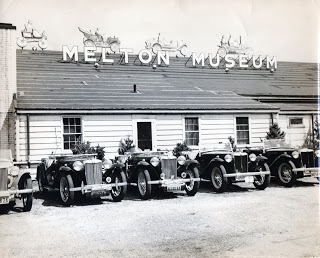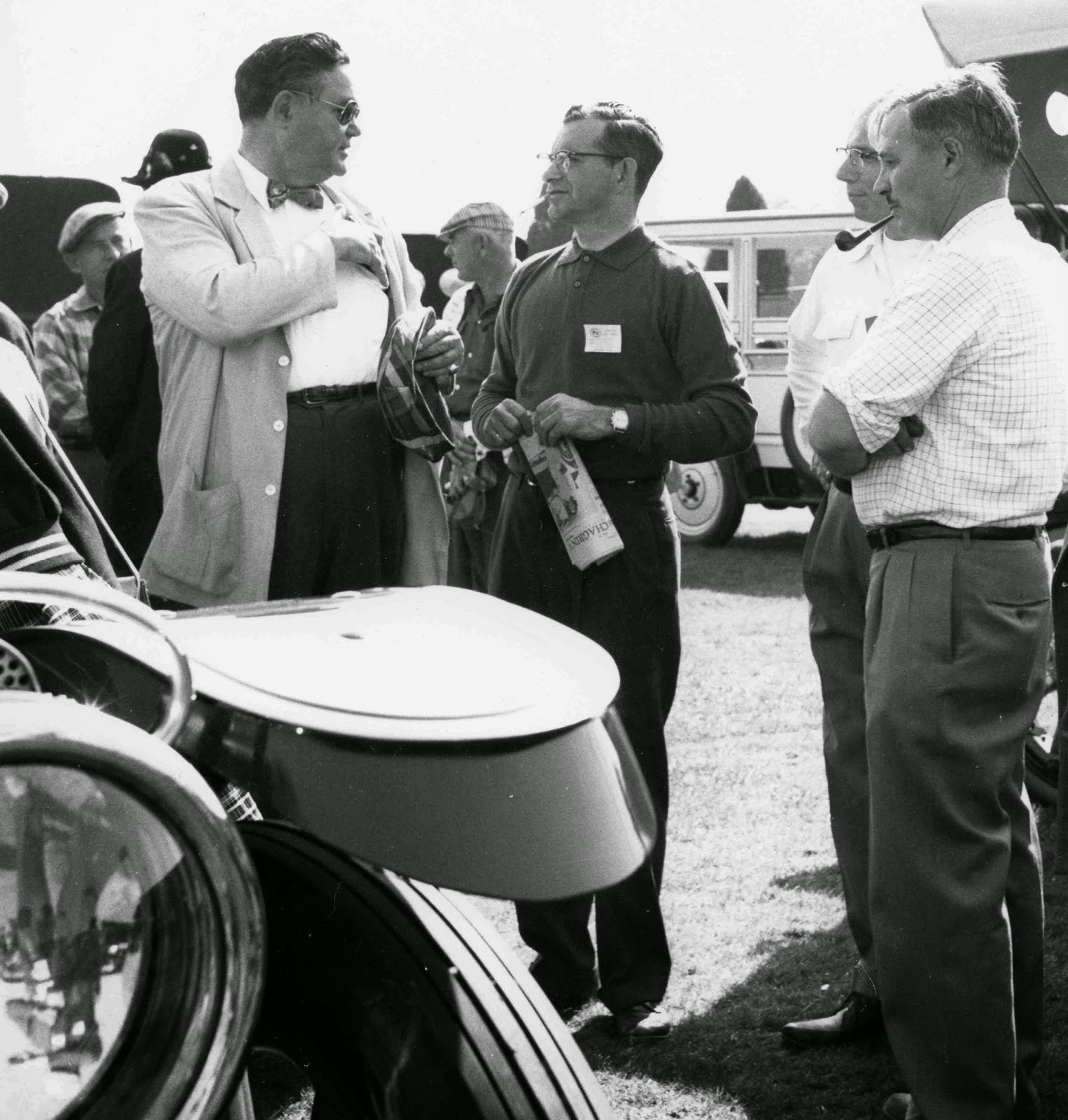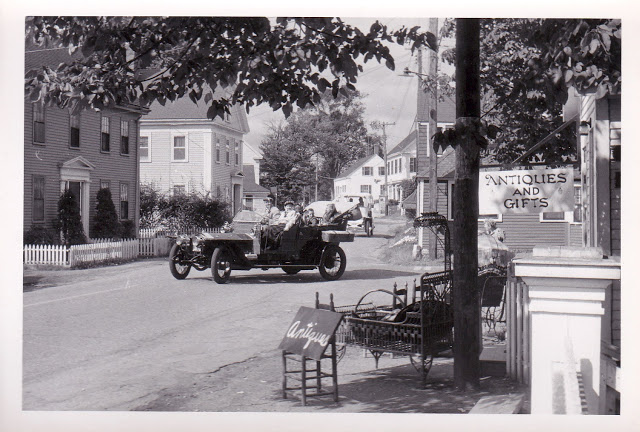Flashback: The Melton Auto Museum opened in Norwalk, Connecticut on July 24, 1948
By Margo Melton Nutt
Reprinted from February 11, 2011
Norwich, VT – Although I have talked some in previous posts about the James Melton Autorama in Florida, I haven’t said much about its precursor, the Melton Museum in Norwalk Connecticut (1948-53). So here goes:
Back in the summer of 1941, the State of Connecticut had appropriated funds to build a museum for my father’s cars. But the onset of World War II put the project on hold. After the war the agreement still did not come to fruition. As he put it in a letter to fellow Veteran Motor Car Club members in 1947:
“As you may have seen by the papers, I have withdrawn my offer of a museum collection to the State of Connecticut. The first appropriation was made in 1941, the enlarged appropriation in 1945, and the thing is still only on paper…The combination of dilly-dallying techniques, small brother groups crying over locations, appointment of an antique auto curator—repeat curator!—and the shifting sands of politics—of which I want no part—finally made me decide that it would be in the best interests of my collection and the antique automobile movement as a whole, to cut out of all that complicated and unpleasant situation…I shall create a museum of which we can all be proud—and where we won’t wake up some morning to find some Politico’s Aunt Tillie’s 1928 Model A Ford where a Mercer Raceabout ought to be.”
Rather than donating his collection to the State in return for the building, he continued to own the cars—and to add to their number until he had close to a hundred. He formed a corporation, The Melton Museum, Inc., and acquired a 10,000 square foot building on an eight-acre site on Route 7 in Norwalk, Connecticut, half a mile from the Merritt Parkway (where Wal-Mart is today). To that he added another 10,000 square foot building, incorporating an existing well-known restaurant, called the Stirrup Cup. On top of the building with the sign saying The Melton Museum, he put brightly painted cutouts of some of the cars represented in the collection; out front he placed a 1902 trolley car. He sincerely believed that everyone was as interested in the history of the automobile as he was. He felt that preserving the cars was only half the story, they should be shown to the public as examples of man’s ingenuity and as the beautiful antiques they were.
On July 24, 1948, the 20,000 square foot Melton Museum of Antique Automobiles opened in Norwalk, with fifty-five cars, antique bicycles, auto accessories, toy trains and music boxes. Opening day began with a parade of antique autos, driven by his confreres from the Veteran Motor Car Club, and was attended by celebrities such as Clare Booth Luce, Lawrence Tibbett and Connecticut Governor Grover Whelan. Twelve hundred paying customers came the first day, sixteen hundred the second. Little did many of the visitors know what a huge, last-minute effort had gone into readying the exhibition for opening day? Firestone, for instance, had agreed to equip all the cars with their new “non-skid” tires—the words formed the tread design. The tires had been flown in by air freight from Akron, Ohio the day before the museum opened, and Firestone men had worked until 2 A.M. to mount them all. For months my mother had been a willing helper in preparing the museum, haunting local antiques stores in search of the right accouterments to accompany the displays, and raiding friends’ and relatives’ attics for old-fashioned costumes for the mannequins to wear. She also oversaw many museum-related details on the home front while her husband was on tour with the Metropolitan Opera that spring.
Their old friend, former Ziegfeld designer, John Harkrider, designed the exhibits. The entrance hall was decorated with large photos of my father’s various old car exploits with other celebrities: the 1937 Easter Parade of antique autos down Fifth Avenue with fellow singers Lanny Ross and Jessica Dragonette as passengers; Edgar Bergen and Charlie McCarthy riding in one of the cars my father took to Hollywood in 1944; and a meeting with Henry Ford Sr. in Dearborn, Michigan. The cashier’s office was in a 1912 Renault Hansom Cab, the car’s radiator having been converted to a counter for selling tickets. (Admission to the museum was 60 cents.) One exhibit room had a parade of vehicles filled with cap-and-duster clad mannequins intended to look as if they were driving down a country road. Another room had eight racing cars displayed in an octagonal pattern; one of the cars was a 1911 Mercedes which was accompanied by a huge photographic blowup of Ralph DePalma driving that very car in the 1911 Vanderbilt Cup Race. In yet another room, the sign in front of the 1910 White Touring Car explained the origins of the collection, “The ambition of a small boy to own a car like this is what started the whole thing.”
He hired a retired Norwalk policeman—Officer Phillip O’Grady—as the security guard. Dressed like a turn of the century Keystone Kop, O’Grady was straight out of central casting, and played his part to the hilt. Among the summer help my father hired was Joe Ryan, still only in high school, to polish brass and run errands. Over fifty years later, among the highlights Ryan recalled was a trip to Canada to pick up a 1924 Rolls Royce that Lady Eaton had donated to the museum. “Between being held up at the border for two days because Customs didn’t accept the paperwork I carried, (they had to verify it with both Lady Eaton and your father), and the fact the headlights were so dim I could only drive in daylight, it took me five days to get the car back to Norwalk.” His job at the Melton Museum started Ryan’s lifelong love of automobiles that evolved into his career as sales manager of a Mercedes Benz agency.
The oldest car in the Melton Museum was 1893 custom steam stage coach, which looked rather like a horse-drawn carriage with engines added front and rear. The most modern car in the museum was a 1934 custom-built Detroit Electric. Other unusual pieces in the collection were aforementioned 1911 Mercedes of Vanderbilt Cup Race fame, a 1900 Rockwell Hansom Cab—the first New York City taxi— and a 12-passenger Stanley Steamer Mountain Wagon circa 1915, formerly used in Yellowstone National Park for sightseeing tours.
Margo Melton Nutt’s memoirs of her father “James Melton: The Tenor of His Times” is available at Amazon.com
James Melton (left) at the Hershey Meet in 1958 beside a 1910 Thomas Flyer



